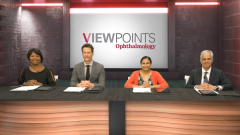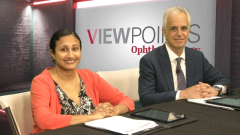
New Therapies to Supplement Anti-VEGF Treatments in Neovascular AMD and DME
Expert retina specialists discuss the OPT-302 study and the challenges presented when using 2 agents in tandem to treat diabetic macular edema.
Episodes in this series

Nathan Steinle, MD: One of the clinical programs I’ve been involved with a lot is the OPT-302 trials. I was in the phase 1, phase 2, and phase 3 trials for it, so it’s one I know pretty well. So far we’ve been talking about anti-VEGF, and we say anti-VEGF, but you mentioned one time it’s anti-VEGF-A. With OPT-302, they’re looking at anti-VEGF-C and D.
And so, they’re doing 2 different injections. Mostly, it’s ranibizumab but now with some of the newer trials they’re looking at aflibercept and they’re adding on top of it a second injection. It’s not coformulated but 2 separate injections. And the second injection is a specific anti-VEGF-C and D inhibitor. And so, it’ll be really interesting to see how that plays out in the real-world A, to get 2 different injections and also have a different mechanism of action to go after. And their trials for wet AMD [age-related macular degeneration] are mostly enrolled now looking at their phase 3 program. So, it’ll be going forward.
Carl Regillo, MD, FACS, FASRS: I was going to say this is a high bar because we’ve gone down this road before because the primary objective here is not durability play, it’s to add on a drug that is combination therapy to get better vision gains. It’s a superiority study. We’ve been talking, everything has been compared to a prior approved drug in mostly anti-VEGF-A and noninferiority trials. So, superiority, we tried it before with anti-PDGF added on to anti-VEGF-A, and it didn’t work. But you’re right. This looks promising. Phase 2 looks pretty darn good for better vision gains, and increased BCVA [best-corrected visual acuity] from baseline compared to just monotherapy anti-VEGF-A. I’m pretty excited but I’m cautiously optimistic as I should probably say.
Adrienne Scott, MD: So, are we talking about 2 different injections for the same patient in the same setting?
Nathan Steinle, MD: Yes.
Adrienne Scott, MD: How do we feel about that logistically and do you think that’s a tough sell to the patients?
Nathan Steinle, MD: I think it is a tough sell to the patients. And they are looking at 2 different injections separated by a half an hour time point. And I think it’s going to be difficult for our clinics just from a flow standpoint. I’m also worried about the pressure on that patient over time. What are your thoughts?
Carl Regillo, MD, FACS, FASRS: Our future is, I think the writing’s on the wall because we now have our first geographic atrophy injection. And those patients will get wet AMD over time, or we might treat our wet AMD patients that are developing atrophy. So, the notion of 2 injections of 2 different drugs is coming in our very near future and if this trial is successful, I think absolutely considering starting with patients, especially patients with more decreased vision to try to get better vision gains. And that’s exactly how the OPT-302 study is designed, patients with more decreased vision upfront with nuance at wet AMD.
Transcript edited for clarity
Newsletter
Keep your retina practice on the forefront—subscribe for expert analysis and emerging trends in retinal disease management.



















































